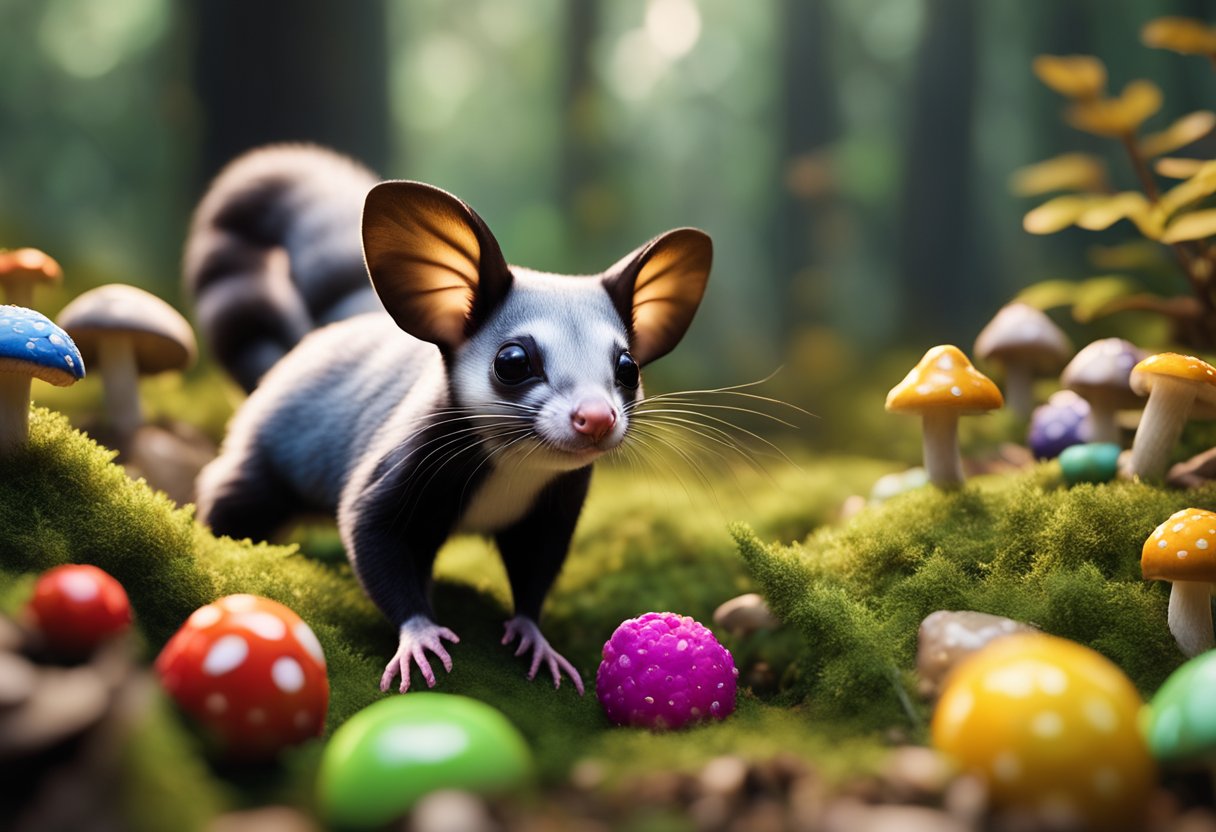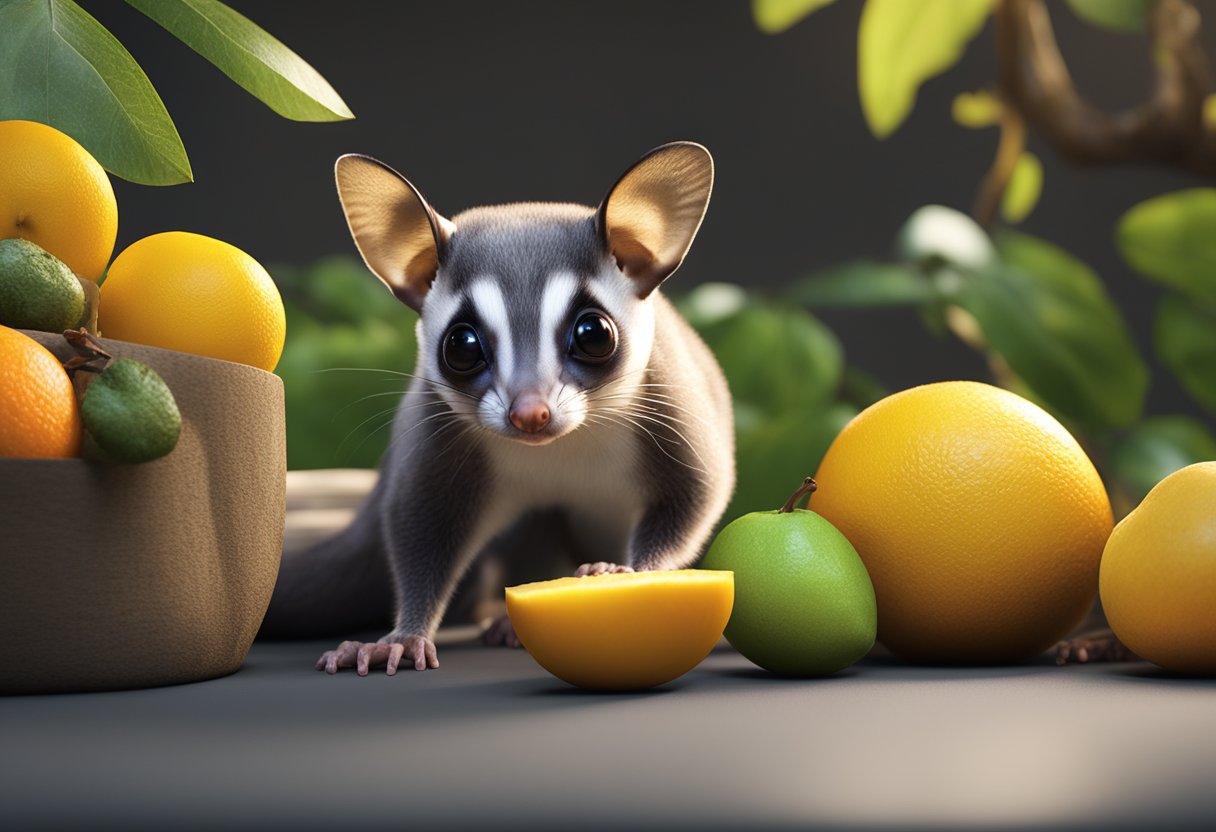
Are you privy to the secrets of a sugar glider nutrition suggested explicitly by experts? Have you ever questioned what foods might pose a threat to your pet sugar glider’s health? When it comes to ensuring a safe diet for sugar gliders, many pet owners underestimate the potential hazards lurking in their own kitchen cabinets. This article delves into the often-overlooked realm of sugar gliders avoiding toxic foods, shedding light on the vital dietary guidelines for these adorable creatures.
Understanding Sugar Glider Dietary Requirements
Comprehending the nutritional needs of sugar gliders is pivotal for their wellbeing. These exotic pets thrive when supplied with a balanced percentage of proteins, fats, carbohydrates, and essential vitamins and minerals. Let’s delve deeper into this.
Essential Nutrients for Sugar Glider Health
Among the key nutrients necessary for sugar glider health, protein stands out because it aids in tissue growth and repair. Fats contribute to energy provision, while carbohydrates form a critical component in their diet for boosted physical activity. Lastly, a variety of vitamins and minerals are crucial in small proportions for proper function of the body processes.
In addition to these nutrients, it is equally important to ensure sugar gliders have continual access to fresh water.
Common Dietary Mistakes in Caring for Sugar Gliders
Despite a pet owner’s best intentions, it’s fairly common to encounter dietary mishaps that can detrimentally impact a sugar glider’s health. Serving improper portions of food, relying on a fruit-only diet, or resorting to feeding inappropriate human food can all lead to nutritional imbalances in sugar gliders.
Being aware of the dietary mistakes can go a long way in providing quality care and promoting sugar glider health.
Variety and Balance in a Sugar Glider’s Diet
Variety and balance in diet are integral to prevent nutritional deficiencies. By offering a diversity of safe fruits, insects, and vegetables, we can ensure they are consuming a range of different nutrients aiding their overall health and happiness.
In conclusion, an optimal sugar glider diet is balanced, varying and rich in all essential nutrients. Awareness of common dietary mistakes can further ensure their long-term health and vitality.
The Dangers of Improper Feeding

Despite their small size and adorable appearance, sugar gliders have specific dietary needs. Failure to adhere to these needs and the unintentional offering of toxic foods can put your beloved pet at risk. In this section, we will explain the food dangers for sugar gliders, show you the signs of dietary distress in sugar gliders, and guide you through the immediate actions for toxic ingestion you should take if you suspect your sugar glider has eaten something harmful.
How Toxic Foods Affect Sugar Glider Well-being
While a variety of household foods might seem harmless to us, they can present serious hazards to sugar gliders. The ingestion of toxic foods can result in a range of health issues, from mild gastrointestinal disturbances to severe neurological damage, and, in worst cases, death. Specific foods pose their own unique dangers. For example, chocolate contains theobromine, which sugar gliders cannot metabolize effectively, leading to serious and potentially fatal toxicity.
Signs of Dietary Distress in Sugar Gliders
If a sugar glider is suffering from dietary distress, it may show signs such as vomiting, diarrhea, loss of appetite, lethargy, and excessive thirst. More severe poisoning symptoms may include seizures, difficulty breathing, or unresponsiveness. It’s crucial to monitor your sugar glider’s behavior and look out for these signs, particularly if you suspect they’ve had access to harmful foods.
Immediate Actions if a Sugar Glider Ingests Harmful Foods
If you believe your sugar glider has ingested a toxic substance, it is critical to act fast. First, remove any remaining harmful food from the sugar glider’s reach. Then, contact your vet immediately, even if your sugar glider isn’t showing any obvious signs of distress. If possible, bring a sample of the ingested substance with you to the vet. Remember, prompt intervention could save your sugar glider’s life.
| Toxic Food | Signs of Distress | Immediate Actions |
|---|---|---|
| Chocolate | Vomiting, diarrhea, seizures | Contact a vet immediately |
| Coffee | Hyperactivity, restlessness, abnormal heart rhythm | Contact a vet immediately |
| Onions, Garlic | Lethargy, loss of appetite, pale gums | Contact a vet immediately |
Sugar Gliders Avoiding Toxic Foods
Ensuring the safety of our beloved sugar gliders involves understanding the substances that are toxic to their health. Many everyday foods, seemingly harmless to us, may contain toxic ingredients for sugar gliders which can have adverse effects on their health. This crucial insight will guide you in safeguarding your pet from potential dietary dangers.
A variety of foods that we typically consume are surprisingly harmful to sugar gliders, and the reasons are worth exploring. To illustrate, we have compiled a handy guide below. It outlines some of the common foods and the toxic ingredients they contain which are harmful to sugar gliders. This table serves as an awareness tool for sugar glider owners to maintain vigilance when feeding their pets.
| Common Food | Toxic Ingredient | Effect on Sugar Gliders |
|---|---|---|
| Chocolate | Theobromine | Overstimulates the central nervous system leading to potential fatal conditions |
| Garlic and Onions | Thiosulphate | Leads to anemia by destroying the red blood cells |
| Avocado | Persin | Causes diarrhea, vomiting, and even heart failure |
| Alcohol | Ethanol | Can lead to alcohol poisoning |
Apart from steering clear of the mentioned toxic ingredients, adopting proactive measures can contribute to your sugar glider’s well-being. One essential sugar glider health tip is to maintain a well-balanced, varied diet comprising proteins, fibers, vitamins, and carbohydrates. You can achieve this by providing a mix of fruits, vegetables, and high-quality sugar glider pellets.
Moreover, keep a close watch on your pet’s behavior and physical condition. In case of any sudden changes, do not hesitate to seek professional veterinary guidance. Remember, safe feeding practices rank high alongside affection and care in ensuring the health and happiness of your sugar glider.
“The first step in successful sugar glider ownership is understanding and providing the right nutrition. The safety of these fascinating creatures largely depends on what they eat and don’t eat. A well-informed owner can significantly contribute to their pet’s well-being.”
Common Toxic Foods to Eliminate from a Sugar Glider’s Diet
To ensure the overall health of your sugar glider, you must be aware of certain human foods that are harmful to them. It’s not just about knowing what they can eat, but equally important is understanding what foods to strictly avoid.
Human Foods That Are Poisonous to Sugar Gliders
Sugar gliders are susceptible to various human foods which can cause serious health problems. Some of the common foods which are toxic to sugar gliders include chocolate, caffeine, onions, garlic, alcohol, and certain fruits like avocado and unripe tomatoes. Foods high in fat, salt, sugar, or preservatives should also be avoided.
The Risks of Feeding Sugar Gliders Table Scraps
Offering table scraps to sugar gliders, though it may seem harmless, can pose serious dangers. Processed and cooked foods are typically high in fat, salt, and sugar and often contain spices and seasonings that are harmful to sugar gliders. In addition, many snacks and desserts include chocolate or caffeine, both of which are toxic to sugar gliders.
Inadvertently Dangerous Treats
Even treats that are generally considered healthy for humans can pose a risk for sugar gliders. Certain fruits, like citrus fruits and grapes, can be harmful to sugar gliders. Raw honey, despite its nutritional value for humans, carries the risk of botulism for these tiny marsupials.
Remember, when it comes to feeding your sugar glider, it’s essential to do your research and consult with a vet.
This would help ensure your sugar glider’s diet doesn’t include any toxic foods while maximizing the nutritional benefits they receive.
Constructing a Safe Diet for Sugar Gliders
Effectively managing sugar glider nutrition is essential for their health and overall well-being. A well-rounded, safe diet for sugar gliders requires a combination of natural food sources, commercial pet foods, and dietary supplements. But the question remains, what are the best choices for their nutrition? Here’s a quick guide to help you get started.
Finding a balance and tailoring the diet to meet the unique needs of your sugar glider should always be a priority.
When formulating a diet for sugar gliders, start with natural vegetables and fruits. These provide necessary vitamins and nutrients that are critical to their health. Here are some options you should consider:
- Papaya
- Mangoes
- Apples
- Carrots
Next, protein is an indispensable part of a sugar glider’s diet. The amount of protein your pet needs can be acquired from various sources such as:
- Chicken breast
- Turkey
- Mealworms
- Boiled eggs
Commercial pet foods are also a great addition to the diet. These foods are specially formulated to promote the health of your sugar glider by meeting their particular dietary requirements. Remember, however, that these should not make up the entirety of your glider’s diet, but rather as a supplement to fresh, natural foods.
Remember to read the labels of commercial pet food. It is crucial that they are designed specifically for sugar gliders and are free of harmful ingredients.
Lastly, dietary supplements such as calcium and vitamins are also recommended to enhance the nutritional quality of the diet, especially when natural food sources do not provide enough of certain nutrients.
To offer a clearer picture, let’s consider an example of a daily diet routine for a sugar glider, along with sugar glider health tips:
| Time of Day | Meal |
|---|---|
| Morning | A slice of apple and calcium supplement |
| Afternoon | Commercial pet food and a couple of mealworms |
| Evening | Small piece of chicken breast and mango |
Please note that individual requirements may vary. Always consult with a veterinarian or pet nutritionist to develop the most appropriate diet plan for your sugar glider.
Conclusion
In light of our comprehensive discussion, it becomes evident that the pillars of sugar glider nutrition lie in understanding their unique dietary requirements, avoiding consumption of toxic foods, and practicing the best methods of sugar glider food safety.
Summarizing Sugar Glider Nutritional Needs
A balanced and nutrient-rich diet is non-negotiable for the optimal health and longevity of sugar gliders. While variety plays a crucial role in preventing nutritional deficiencies, it should always be backed with a sound understanding of safe food choices for sugar gliders.
Best Practices for Sugar Glider Food Safety
Foods that are safe for humans may be harmful, even fatal, to sugar gliders. Existing in our everyday food items, certain ingredients prove toxic to sugar gliders. This highlights the urgency to identify and eliminate such potentially toxic foods from a sugar glider’s diet— underpinning the importance of obligatory food safety practices for these charming creatures.
The Role of Responsible Ownership in Dietary Care
Ownership of a sugar glider goes beyond mere fascination, it also requires in-depth knowledge of their nutritional needs. Responsible ownership in dietary care entails meticulous scrutiny of food items, immediate action in case of accidental ingestion of harmful substances, and continuous learning about sugar glider nutrition. In conclusion, the well-being of sugar gliders rests significantly on our shoulders, driving us to foster an environment that mirrors their natural diet as closely as possible.

Leave a Reply